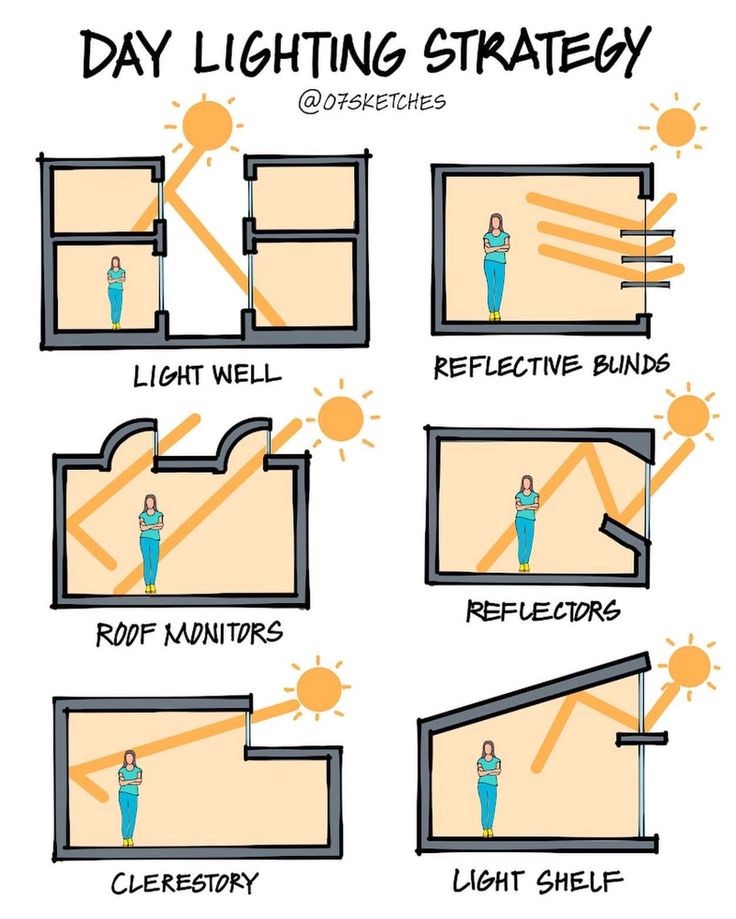From light wells to reflective blinds, architects are embracing innovative designs that reduce energy costs, improve comfort, and reconnect people with natural light.
🌍 The Power of Daylight
For centuries, sunlight has been humanity’s primary source of light. Yet in modern times, artificial lighting has taken over — often at the cost of higher energy bills, environmental impact, and even human well-being.
Architects and engineers today are rediscovering the art of daylighting — designing buildings that maximize natural sunlight for interior spaces. This approach is not only eco-friendly, but also healthier, more cost-effective, and aesthetically pleasing.
Daylighting isn’t just about adding more windows. It’s about using strategic architectural techniques to channel, reflect, and diffuse sunlight so it penetrates deep into spaces without glare or overheating.
The diagram highlights six effective strategies: Light Wells, Reflective Blinds, Roof Monitors, Reflectors, Clerestory Windows, and Light Shelves. Each has unique advantages and applications.
1. 🌞 Light Wells
A light well is a vertical shaft that brings sunlight into the core of a building. Imagine a tall apartment block — the rooms in the middle rarely see daylight. By carving a narrow open space (a “well”), sunlight can travel down multiple floors, brightening interior areas that would otherwise remain dark.
Benefits:
- Provides daylight to deep-plan buildings.
- Improves ventilation when designed as an open shaft.
- Creates visual connection to the outdoors.
Applications:
- Common in historical European housing blocks.
- Increasingly used in modern high-density cities where space is limited.
2. 🌞 Reflective Blinds
Unlike ordinary blinds that block sunlight, reflective blinds are tilted to bounce sunlight upwards. Instead of causing glare on desks or screens, the light is reflected toward the ceiling, which then diffuses it softly throughout the room.
Benefits:
- Reduces glare while still using natural light.
- Keeps rooms bright without overheating.
- Allows occupants to control brightness.
Applications:
- Offices, classrooms, and homes where screen use is high.
- Energy-efficient retrofits for existing windows.
3. 🌞 Roof Monitors
Roof monitors are elevated structures on rooftops that capture sunlight and direct it downward. Unlike skylights, they can be angled to face the sun’s path, ensuring maximum daylight.
Benefits:
- Captures consistent light throughout the day.
- Reduces reliance on artificial lights in large halls.
- Adds architectural interest to rooflines.
Applications:
- Industrial buildings, warehouses, gymnasiums.
- Modern eco-homes with flat or sloped roofs.
4. 🌞 Reflectors
Reflectors are panels or surfaces — sometimes mirrors or polished materials — placed inside or outside a building to bounce light deeper into rooms.
Benefits:
- Extends daylight penetration.
- Useful for narrow, long spaces.
- Can be combined with other daylighting tools (e.g., clerestories).
Applications:
- Urban houses where adjacent buildings block direct light.
- Energy-conscious commercial interiors.
5. 🌞 Clerestory Windows
Clerestories are high windows placed near the top of walls, above eye level. These windows admit light while maintaining privacy and wall space for furniture.
Benefits:
- Provides even daylight distribution.
- Avoids glare since the sun is higher.
- Helps with passive solar heating in colder climates.
Applications:
- Churches and cathedrals (historical use).
- Modern homes seeking a blend of privacy and light.
6. 🌞 Light Shelves
A light shelf is a horizontal surface (inside or outside the building) that reflects sunlight upwards onto the ceiling. The ceiling then diffuses the light deeper into the space.
Benefits:
- Brightens interiors without direct glare.
- Reduces need for artificial lighting even in deep rooms.
- Works well with high-performance glass.
Applications:
- Offices, schools, and libraries.
- Sustainable architecture in hot climates.
🌱 Environmental & Human Benefits
Daylighting is not just about saving electricity. It has profound impacts:
- Energy Savings: Lighting consumes about 20–30% of building energy. Daylighting drastically cuts this.
- Thermal Comfort: Smart daylighting reduces heat gain, keeping interiors cooler.
- Health Benefits: Exposure to natural light improves mood, regulates sleep cycles, and boosts productivity.
- Sustainability: Reduces carbon footprint, aligning with green building standards like LEED and BREEAM.
🏛️ Tradition Meets Innovation
Many traditional architectures already mastered daylighting:
- Roman atriums with central courtyards (light wells).
- Islamic mashrabiyas that filtered light through wooden screens.
- Japanese shoji screens that diffused sunlight softly.
Modern architects are reinterpreting these techniques with glass, reflective coatings, and computational modeling to maximize efficiency.
🚀 The Future of Daylighting
Emerging technologies are making daylighting smarter:
- Dynamic Glass: Windows that adjust tint automatically to sunlight.
- Fiber Optic Sunlight Pipes: Collect sunlight on rooftops and channel it inside through fiber optics.
- AI-Optimized Building Design: Software simulations to predict and optimize daylight performance.
These innovations promise buildings that are not just illuminated, but also energy-independent and climate-responsive.
🏠 Final Takeaway
Daylighting is more than a design trend — it’s a sustainable necessity. By using strategies like light wells, reflective blinds, roof monitors, reflectors, clerestory windows, and light shelves, buildings can become brighter, healthier, and greener.
In a world where energy efficiency and wellness are top priorities, daylighting is proving that the best light source has always been above us — the sun. ☀️
